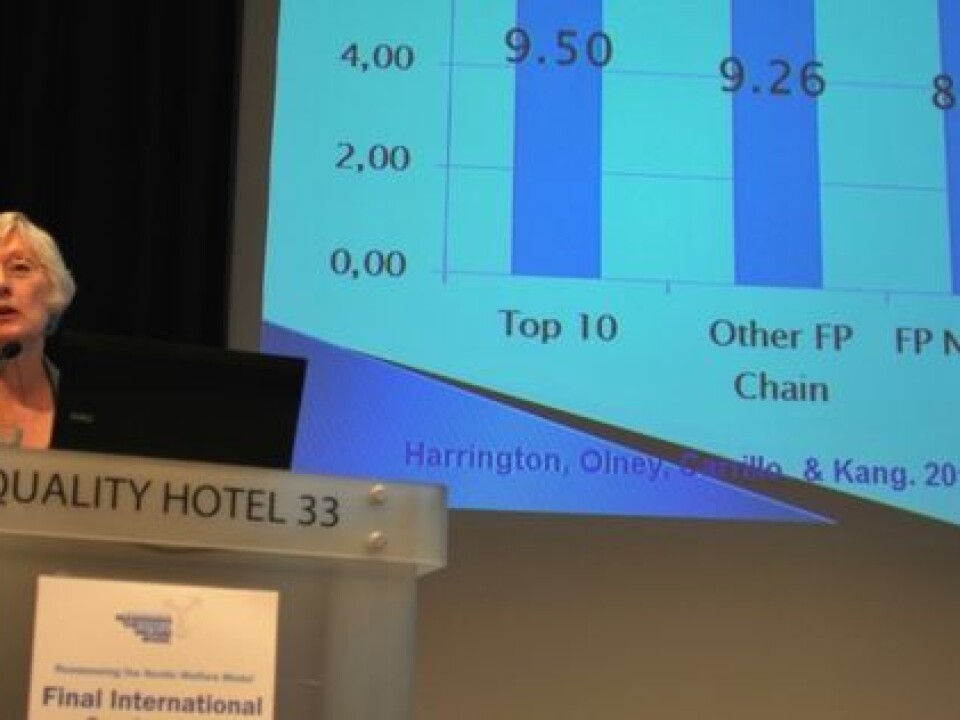
Health care and business don't mix
Using private companies to provide health care on a for-profit basis is not a viable model, warn researchers. The market wins – and patients lose.
Denne artikkelen er over ti år gammel og kan inneholde utdatert informasjon.
Privatising health care is often promoted as a way of ensuring cheaper and better care through competition, rather than relying on a less efficient public sector without the need to compete.
But a market economy in the health sector doesn't work, according to research presented at a conference hosted in Oslo by the REASSESS - Reassessing the Nordic Welfare Model - research centre.
Completely incompatible
“Private business and healthcare are completely incompatible,” says Charlene Harrington, professor emeritus at the University of California, San Francisco.
She has examined the ten largest commercial health care providers in the United States, together accounting for 13-14 percent of the domestic health care market. Almost 70 percent of US health care facilities are run on a for-profit basis, and only six percent are run as public institutions. The remaining are private non-profit ventures.
A vast majority in breach of regulations

According to Harrington, 94 percent of US care homes are in breach of federal regulations for health care standards. As many as 23 percent of the homes were so badly managed that they had caused serious injury to the patients.
“Only ten percent of the care homes have what we could characterise as a proper level of care, and up to a quarter of them should likely be closed.”
Harrington adds that the largest franchises are a good indicator of how the market works, since they have the most revenue and set the trends for the rest of the sector.
Most failures in largest franchises
“In our studies the top ten chains had the largest amount of faults and failures, and the most serious failures. They had the sickest patients, the least number of staff per patient, and the most untrained nurses,” she points out.
“Even using very complex models where we corrected for variation between states, geographical differences in market dynamics, demography and other parameters, the same pattern emerged.”
The findings show that the largest franchises have 36 percent more registered faults and failures and 41 percent more serious failures than care homes run by the public sector.
Too complex health sector
Professor Susan Himmelweit of the UK's Open University argues that the health sector is simply too complex for a market economy to deliver effective solutions.
“One example is how the 'customer' – the patient – should be able to make informed decisions on what he or she wants and needs," she says. "While this often is the case for younger patients with stable needs who become experts on what they need, it's rarely the case for older patients. Their needs vary – making it difficult to assess the care services they need.”
The difficulty of 'free choice'
The marked increase in cognitive deficiency-related illnesses, such as Alzheimer's disease, highlights the difficulty of basing a health care model on 'free choice'. If patients are unable to carry out basic tasks, they will hardly be able to make choices on care home or type of care.
In order to make an informed choice, the patient also needs time and the opportunity to look into the different options.
“However, in health care, choices often have to be made quickly,” argues Himmelweit.
“People would rarely know what the different options entailed in terms of pros and cons, and most patients would not be used to making choices like this. Experience is an important part of getting the best options available on the market.”
A dysfunctional market
In a functioning market, both consumers and providers need to be able to access viable alternatives. If the market demands lower prices and the seller finds it difficult to lower them, it's an indication that the market isn't working.
“Health care is labour-intensive, and the only way to make it more cost-effective is by cutting staff or hiring untrained personnel at a lower wage,” concludes Himmelweit.
---------------------------
Read the Norwegian version of this article at forskning.no
































